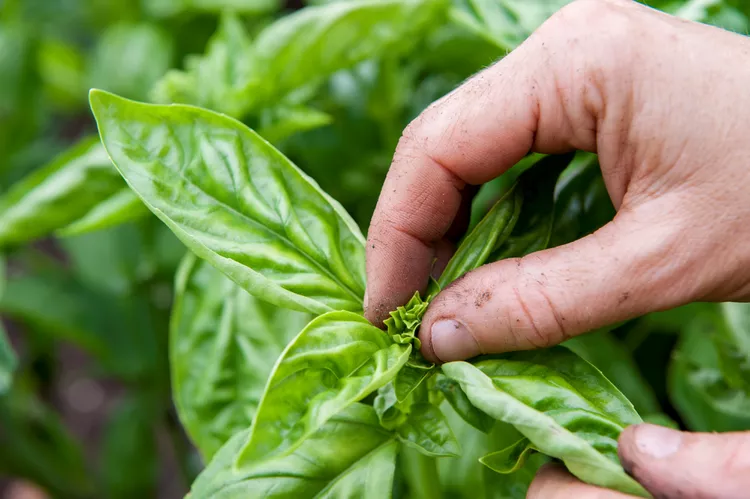Harvesting and pruning basil are similar processes but are done for different purposes. If you’re growing only one basil plant, you'll likely be able to keep up with it by frequently harvesting leaves. But if you have a patch of basil, perhaps with making pesto in mind, you'll need to prune them every week or two. Don't worry, it's fast and easy, and your efforts will be rewarded with lots more tasty basil.
Reasons for Pruning Basil
Gardeners prune basil for three main reasons: to prevent it from flowering, to encourage more growth, and to get cuttings for growing more basil.
1. Prevent basil from flowering.
Basil flowers have a charm of their own, and can be used for decorative bouquets. However, the leaves start to get a bitter flavor once blooming begins. Growth of new tender leaves also slows once the plant has flowered.
In the natural life cycle of the plant, basil grows from seed to seedling, putting out more and more leaves so it can absorb plenty of energy from the sun. As basil reaches full size, like any plant, it will try to reproduce by making flowers and seeds. At this point most energy goes to flowering and seed production.
By pruning the flowers off, you disrupt that cycle, keeping the plant in vegetative mode. It will then keep putting out tasty leaves a little longer before trying to make more flowers.
If you're growing an ornamental basil like Aromatto, you may wish to let some of it flower. But if you want to use the plant for kitchen use, prune the flowers off as soon as they appear.
2. Encourage a bushy shape.
Basil plants, left to their own devices, will be tall, often single-stemmed, somewhat sparsely leafed, and the stems will become tough and woody. Pruning spurs new, tender stems and more leaves to grow.
Just as pruning a shrub results in a more densely formed, shapely plant, pruning basil accomplishes the same. In fact, if you bought an established basil plant from the greenhouse, check it out. You might see a couple old healed-over pruning marks.
After a growing stem is pruned, the basil plant will put out two new branches and focus more on vegetative growth than flowering. When pruned, one stem grows into two. After a couple of weeks, those two stems can be pruned to become four, creating a bushy plant that will provide lots of basil for your recipes.
3. Cuttings for new plants.
Larger pieces pruned off can be used in the kitchen, of course, but they can also be used to grow more basil plants. Basil is an herb that roots very easily in a glass of water or moist potting soil. It's a great way to keep yourself supplied with young basil plants.
How to Prune Basil Plants
Pruning basil plants is easy and fast, and you'll smell like basil doing it! Wait to do the first pruning until your plant is 4-6 inches tall and looks healthy and dark green.
To prune basil:
- Find a node. Look for a point on the stem where two leaves come out opposite each other. If there are two little buds, one at the base of each leaf stem, that's a node.
- Use your fingers, herb snips, or scissors to pinch or snip the stems just above the node, about a ¼ inch higher on the stem.
- Repeat for any stems that are flowering or to force more growth. Avoid removing more than a third of the stem at a time or a third of the entire plant at the same pruning.
That's it; you've pruned your basil. Side branches can be pruned as well. Once the two new stems have grown from the existing node and started to get longer, they can also be pruned.
Tips for Growing Lush, Tasty Basil Plants
Pruning basil will keep it in vegetative growth mode, which is half the battle. Providing an optimum environment will keep your basil growing lots of tasty leaves.
Watering
Basil likes consistent moisture. When growing it in a pot, keep basil in a separate container from herbs like rosemary, thyme, and oregano that prefer drier conditions. And when planting basil in a garden bed, choose companion plants that also appreciate plenty of water.
Light
Basil does best in full sun. While it's easy to find a sunny spot outdoors, if you move your basil indoors for the cooler months, you'll need to ensure it has enough light to thrive. Basil grown indoors in poor light will get leggy. Outdoors, basil likes at least six hours per day of sunshine. Indoors, you'll need a south-facing window or at least 8 hours daily under a grow light for best results.




















